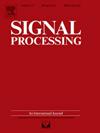Fixed-point fully adaptive interpolated Volterra filter under recursive maximum correntropy
IF 3.4
2区 工程技术
Q2 ENGINEERING, ELECTRICAL & ELECTRONIC
引用次数: 0
Abstract
The second-order Volterra (SOV) filter demonstrates excellent performance for modeling nonlinear systems. The main disadvantage of the adaptive SOV filter is that the number of coefficients increases exponentially with memory length, which hinders its practical applications. To circumvent this problem, the sparse-interpolated Volterra filter has been developed. However, the existing algorithms only investigated the performance of gradient-based interpolators and their performance may degrade for combating impulsive noise. A novel fixed-point fully adaptive interpolated Volterra filter under recursive maximum correntropy (FPFAIV-RMC) algorithm is proposed. In particular, the coefficients of the sparse SOV filter are adapted by the RMC algorithm and the coefficients of the interpolator are updated by the fixed-point algorithm under RMC. Additionally, the convergence of the FPFAIV-RMC algorithm is analyzed. The efficacy of the FPFAIV-RMC algorithm is validated by simulations for nonlinear system identification, nonlinear acoustic echo cancellation (NLAEC), and prediction in impulsive noise.
递归最大熵下的不动点全自适应插值Volterra滤波器
二阶Volterra (SOV)滤波器在非线性系统建模中表现出优异的性能。自适应SOV滤波器的主要缺点是系数的数目随存储器长度呈指数增长,这阻碍了它的实际应用。为了解决这个问题,稀疏插值Volterra滤波器被开发出来。然而,现有的算法只研究了基于梯度的插值器的性能,并且它们的性能在对抗脉冲噪声时可能会下降。提出了一种新的基于递推最大熵(FPFAIV-RMC)算法的不动点全自适应插值Volterra滤波器。其中,稀疏SOV滤波器的系数由RMC算法调整,插值器的系数由RMC下的不动点算法更新。此外,还分析了FPFAIV-RMC算法的收敛性。通过非线性系统识别、非线性声回波消除(NLAEC)和脉冲噪声预测的仿真,验证了FPFAIV-RMC算法的有效性。
本文章由计算机程序翻译,如有差异,请以英文原文为准。
求助全文
约1分钟内获得全文
求助全文
来源期刊

Signal Processing
工程技术-工程:电子与电气
CiteScore
9.20
自引率
9.10%
发文量
309
审稿时长
41 days
期刊介绍:
Signal Processing incorporates all aspects of the theory and practice of signal processing. It features original research work, tutorial and review articles, and accounts of practical developments. It is intended for a rapid dissemination of knowledge and experience to engineers and scientists working in the research, development or practical application of signal processing.
Subject areas covered by the journal include: Signal Theory; Stochastic Processes; Detection and Estimation; Spectral Analysis; Filtering; Signal Processing Systems; Software Developments; Image Processing; Pattern Recognition; Optical Signal Processing; Digital Signal Processing; Multi-dimensional Signal Processing; Communication Signal Processing; Biomedical Signal Processing; Geophysical and Astrophysical Signal Processing; Earth Resources Signal Processing; Acoustic and Vibration Signal Processing; Data Processing; Remote Sensing; Signal Processing Technology; Radar Signal Processing; Sonar Signal Processing; Industrial Applications; New Applications.
 求助内容:
求助内容: 应助结果提醒方式:
应助结果提醒方式:


